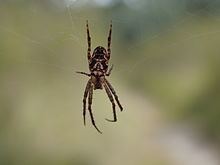Rank Species | Family Araneidae Order Spider | |
 | ||
Similar Araneus bradleyi, Araneus albotriangulus, Araneus illaudatus | ||
The spider species Plebs eburnus is commonly referred to as the Eastern Grass Orb-weaver or the Eastern Bush Orb-weaver, and sometimes more simply the Bush Orb-weaver. It is an orb-weaver spider from the Araneidae family, it is endemic to Australia. It was previously classified as a member of the genus Araneus but has been reclassified in 2012 into a newly described genus Plebs. It is closely related to the Western Bush Orb-weaver, P. cyphoxis. It is a very common spider with distinctive white markings (although these marking can be quite variable), which give it the species name eburnus pertaining to ivory. It is found in scrub and tall grasses where the female constructs a vertical web usually no more than 2 metres from the ground, and stays there day and night. The web of some of these spiders has been seen to be decorated with nearly vertical stabilimentum (like a clockface at 5 minutes to 5 or its mirror image). The stabilimentum of P.cyphoxis is usually observed vertical (like a clockface at 6 o'clock).
Contents
Distribution
P. eburnus can be found in Queensland, New South Wales, Victoria, Tasmania, Australian Capital Territory and South Australia. Some rare occurrences have been observed in Western Australia although this is not part of the typical range of this species. The ranges of this species and P. cyphoxis overlap in South Australia.
Size and markings
On the underside of the abdomen, along with other members of the Plebs genus, there is a characteristic U-shaped white marking with two white spots either side of the spinnerets. The females, as with most spiders, are larger than the males and are around 8mm in length, compared to just 5mm in length for the males.
